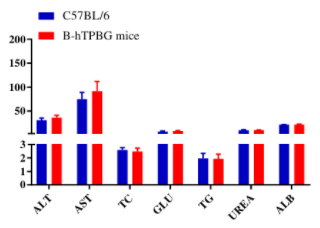|
Strain Name
|
C57BL/6N-Tpbgtm1(TPBG)Bcgen/Bcgen
|
Common Name
|
B-hTPBG mice
|
|
Background
|
C57BL/6N
|
Catalog number
|
111048
|
Related Genes
|
TPBG (Trophoblast glycoprotein), 5T4
|
NCBI Gene ID
|
21983
|
mRNA expression analysis
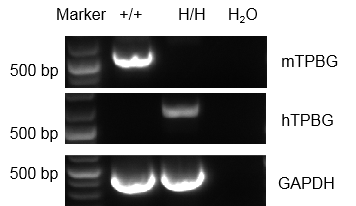
Strain specific analysis of TPBG gene expression in WT and B-hTPBG mice by RT-PCR. Mouse Tpbg mRNA was detectable in splenocytes of wild-type (+/+) mice. Human TPBG mRNA was detectable only in H/H, but not in +/+ mice.
Protein expression analysis
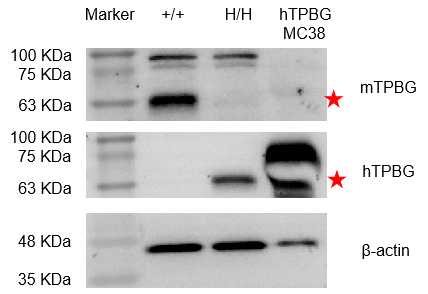
Strain specific analysis of TPBG expression in WT and B-hTPBG mice by western blot. Spine were collected from WT mice and homozygous B-hTPBG (H/H) mice. Mouse TPBG was detectable in WT mice, the observed band size 63 kDa is the target band. Human TPBG was exclusively detectable in homozygous B-hTPBG and hTPBG overexpressed MC38 cells but not WT mice.
Protein expression analysis

Strain specific analysis of TPBG expression in wild-type mice and B-hTPBG mice by western blot. Tissues in the panel were collected from wild-type mice (+/+) and homozygous B-hTPBG mice (H/H), and analyzed by western blotting with species-specific antibodies. Mouse TPBG was detectable in the brain and spine of wild-type mice. Human TPBG was exclusively detectable in the brain and spine of homozygous B-hTPBG mice.

Strain specific analysis of TPBG expression in wild-type mice and B-hTPBG mice by western blot. Tissues in the panel were collected from wild-type mice (+/+) and homozygous B-hTPBG mice (H/H), and analyzed by western blotting with species-crossing antibodies. TPBG was both detectable in the brain and spine of wild-type mice and homozygous B-hTPBG mice.
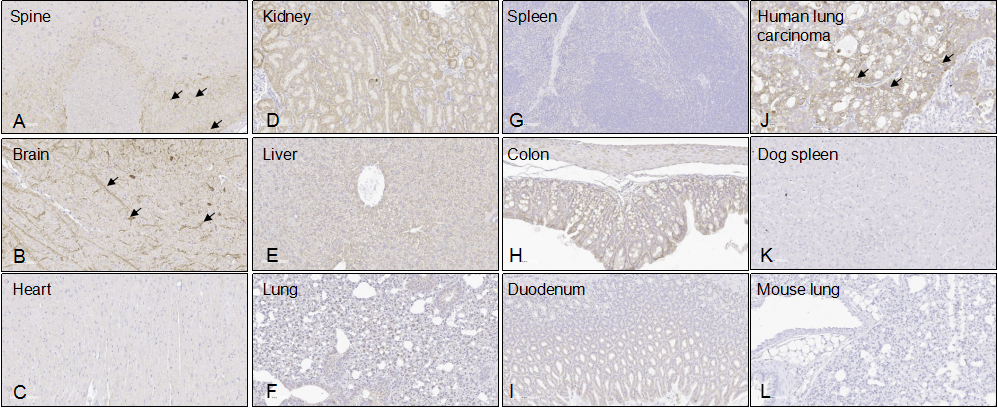
Representative human TPBG expression in different tissues of B-hTPBG mice by IHC. Tissues were stained with antibodies specific for human TPBG (A-K) or anti-IgG antibody (L). Brain and spine of B-hTPBG mice show human TPBG positive. Human TPBG + cells were located in the white matter region of the spinal cord and the cortex region of the brain tissue, respectively. Human lung carcinoma as a positive control (J); Dog spleen was a negative control (K); Mouse lung tissues from the wild-type C57BL/6 mice (L).Other tissues were got from homozygous B-hTPBG mice (A-I). Original magnification ×200. Abbreviations: IHC, immunohistochemistry.
Analysis of leukocytes subpopulation in B-hTPBG mice

Analysis of spleen leukocyte subpopulations by FACS. Splenocytes were isolated from female C57BL/6 and B-hTPBG mice (n=3, 6-week-old). Flow cytometry analysis of the splenocytes was performed to assess leukocyte subpopulations. A. Representative FACS plots. Single live cells were gated for the CD45+ population and used for further analysis as indicated here. B. Results of FACS analysis. Percent of T cells, B cells, NK cells, dendritic cells, granulocytes, monocytes and macrophages in homozygous B-hTPBG mice were similar to those in the C57BL/6 mice, demonstrating that TPBG humanized does not change the overall development, differentiation or distribution of these cell types in spleen. Values are expressed as mean ± SEM.
Analysis of spleen T cell subpopulations in B-hTPBG mice
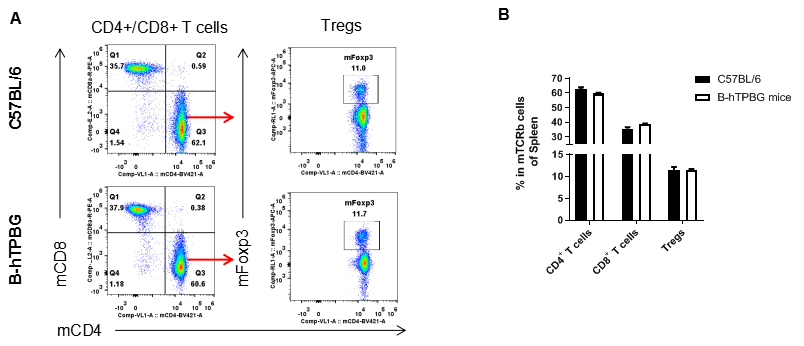
Analysis of spleen T cell subpopulations by FACS. Splenocytes were isolated from female C57BL/6 and B-hTPBG mice (n=3, 6-week-old). Flow cytometry analysis of the splenocytes was performed to assess leukocyte subpopulations. A. Representative FACS plots. Single live CD45+ cells were gated for TCRβ+T cell population and used for further analysis as indicated here. B. Results of FACS analysis. The percent of CD8+ T cells, CD4+ T cells, and Tregs in homozygous B-hTPBG mice were similar to those in the C57BL/6 mice, demonstrating that introduction of hTPBG in place of its mouse counterpart does not change the overall development, differentiation or distribution of these T cell subtypes in spleen. Values are expressed as mean ± SEM.
Analysis of leukocytes subpopulation in TPBG mice

Analysis of lymph node leukocyte subpopulations by FACS. Lymph node was isolated from female C57BL/6 and B-hTPBG mice (n=3, 6-week-old). Flow cytometry analysis of the lymph node was performed to assess leukocyte subpopulations. A. Representative FACS plots. Single live cells were gated for the CD45+ population and used for further analysis as indicated here. B. Results of FACS analysis. Percent of T cells, B cells, NK cells, dendritic cells, granulocytes, monocytes and macrophages in homozygous B-hTPBG mice were similar to those in the C57BL/6 mice, demonstrating that TPBG humanized does not change the overall development, differentiation or distribution of these cell types in lymph node. Values are expressed as mean ± SEM.
Analysis of lymph node T cell subpopulations in B-hTPBG mice
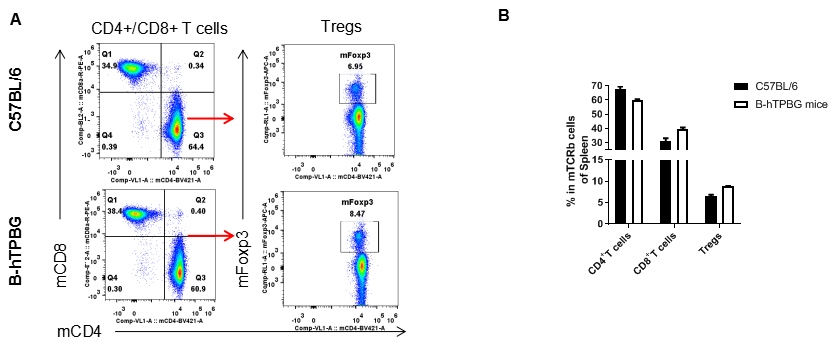
Analysis of lymph node T cell subpopulations by FACS. Lymph node was isolated from female C57BL/6 and B-hTPBG mice (n=3, 6-week-old). Flow cytometry analysis of the lymph node was performed to assess leukocyte subpopulations. A. Representative FACS plots. Single live CD45+ cells were gated for CD3+ T cell population and used for further analysis as indicated here. B. Results of FACS analysis. The percent of CD8+ T cells, CD4+ T cells, and Tregs in homozygous B-hTPBG mice were similar to those in the C57BL/6 mice, demonstrating that introduction of hTPBG in place of its mouse counterpart does not change the overall development, differentiation or distribution of these T cell subtypes in lymph node. Values are expressed as mean ± SEM.
Analysis of leukocytes subpopulation in B-hTPBG mice

Analysis of blood leukocyte subpopulations by FACS. Blood was isolated from female C57BL/6 and B-hTPBG mice (n=3, 6-week-old). Flow cytometry analysis of the blood cells was performed to assess leukocyte subpopulations. A. Representative FACS plots. Single live cells were gated for the CD45+ population and used for further analysis as indicated here. B. Results of FACS analysis. Percent of T cells, B cells, NK cells, dendritic cells, granulocytes, monocytes and macrophages in homozygous B-hTPBG mice were similar to those in the C57BL/6 mice, demonstrating that TPBG humanized does not change the overall development, differentiation or distribution of these cell types in blood. Values are expressed as mean ± SEM.
Analysis of blood T cell subpopulations in B-hTPBG mice
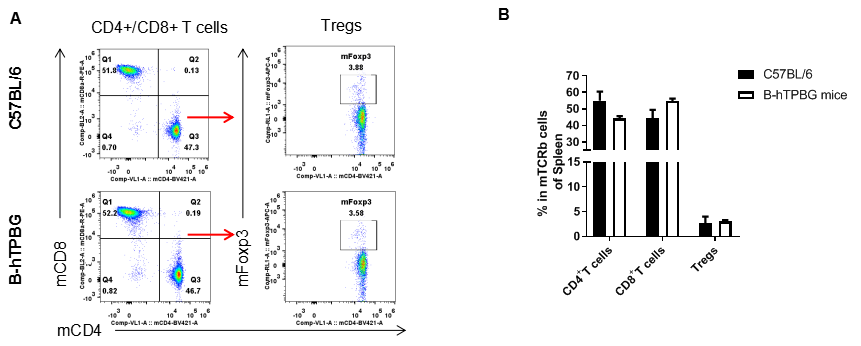
Analysis of blood T cell subpopulations by FACS. Blood was isolated from female C57BL/6 and B-hTPBG mice (n=3, 6-week-old). Flow cytometry analysis of the blood cells was performed to assess leukocyte subpopulations. A. Representative FACS plots. Single live CD45+ cells were gated for CD3+ T cell population and used for further analysis as indicated here. B. Results of FACS analysis. The percent of CD8+ T cells, CD4+ T cells, and Tregs in homozygous B-hTPBG mice were similar to those in the C57BL/6 mice, demonstrating that introduction of hTPBG in place of its mouse counterpart does not change the overall development, differentiation or distribution of these T cell subtypes in blood. Values are expressed as mean ± SEM.
Blood routine test in B-hTPBG mice
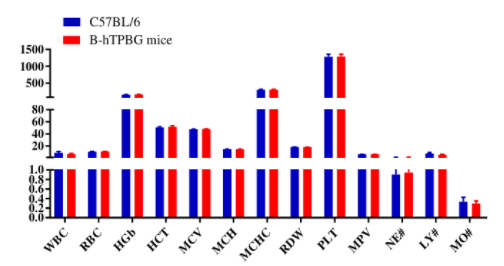
Complete blood count (CBC). Blood from female C57BL/6 and B-hTPBG mice (n=6, 6-8 week-old) was collected and analyzed for CBC. Results indicate that introduction of hTPBG in place of its mouse counterpart does not change blood cell composition and morphology. Values are expressed as mean ± SEM.
Blood chemistry of B-hTPBG mice
Blood chemistry tests of B-hTPBG mice. Serum from the C57BL/6 and B-hTPBG mice (n=6, 6-8 week-old) was collected and analyzed. There was no differences on either measurement between C57BL/6 and B-hTPBG mice, indicating that introduction of hTPBG in place of its mouse counterpart does not change ALT and AST levels or health of liver. Values are expressed as mean ± SEM.












